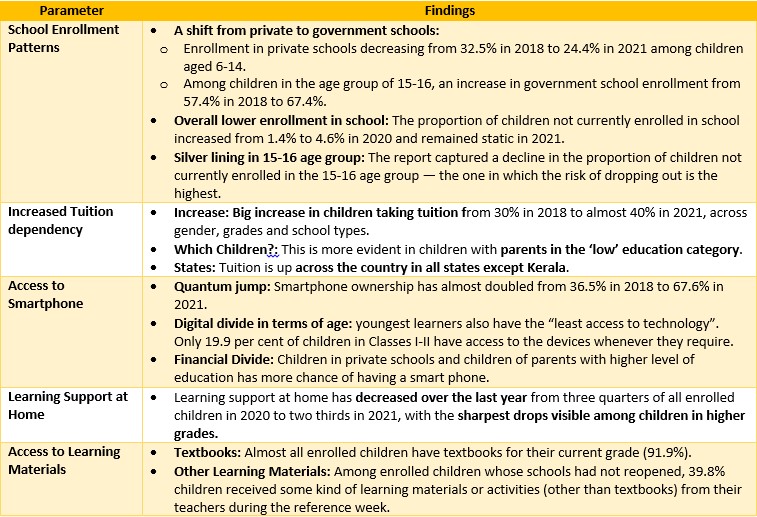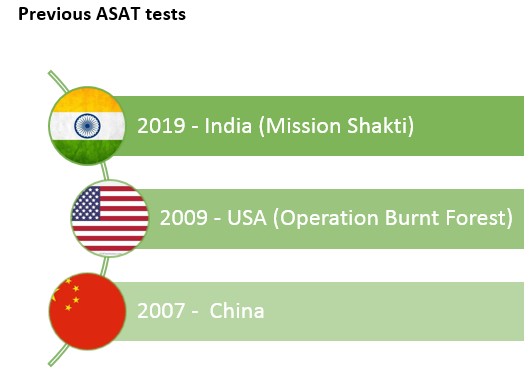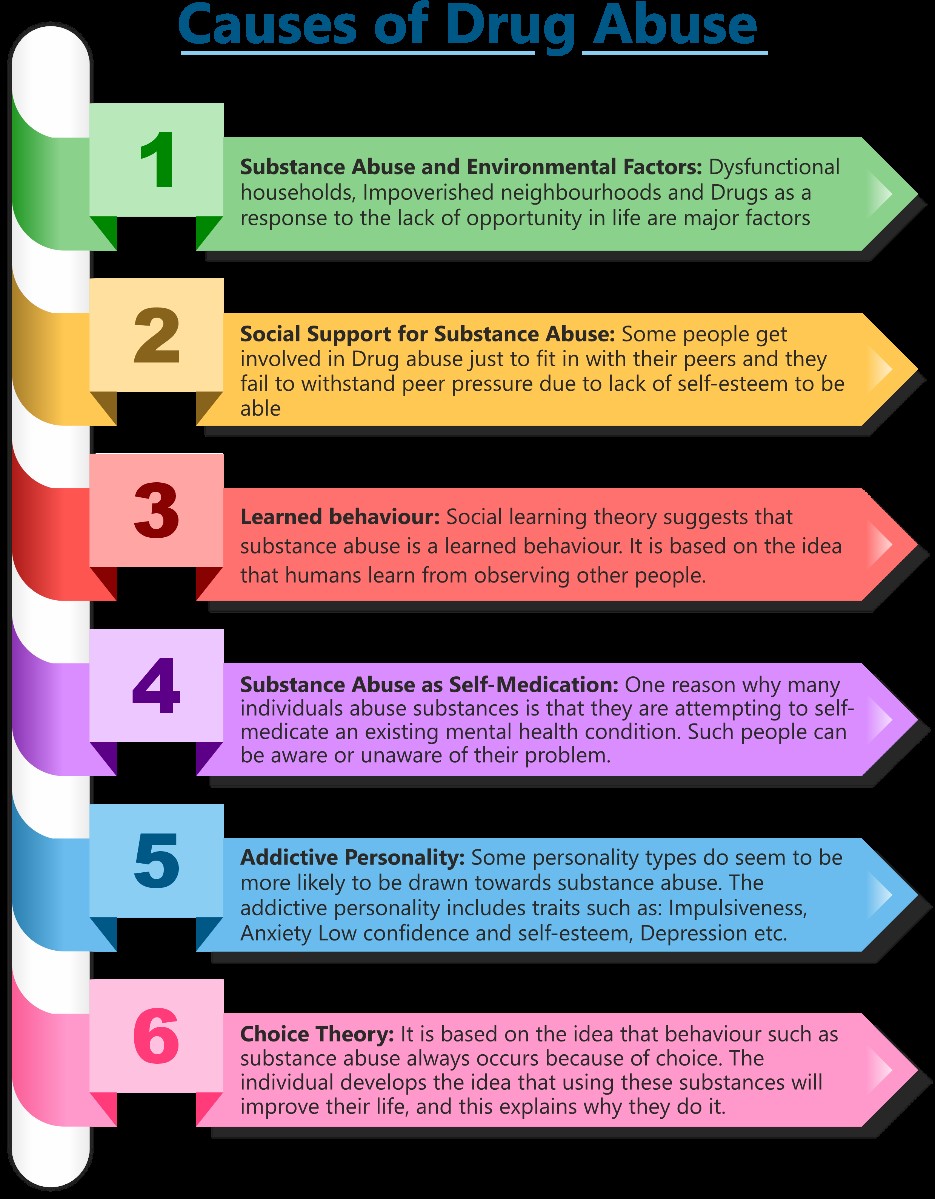Friday, 19th November 2021
Digital Lending Regulations
In News
A working group constituted by the Reserve Bank of India on digital lending through online platforms and mobile apps has submitted its report.
About the News
- The working group (WG) was set up on January 13, 2021, with Jayant Kumar Dash as the Chairman.
- According to the report, there were approximately 1,100 lending apps for Indian android users across more than 80 application stores from January 1, 2021, to February 28, 2021. Of these, 600 were illegal.
- What is digital lending: Digital lending is a process to offer loans online. Every process of the loan lifecycle happens online, and hence, there is no need to visit a bank
- Fin Tech companies utilize their customer’s financial and transactional data to underwrite digital loans over an API (application programming interface) driven approach, thereby substantially lowering the time required to gain personal or payday loans.
- Opportunities
- Digital lending has the potential to make access to financial products and services fairer, efficient and inclusive.
- Digital lending can prove to be a tool acting towards the growth of higher quality of financial services to underserved businesses and people leading to greater financial inclusion.
Committee Recommendations
- Verification: As per findings of the working group, 600 of the 1,100 loan apps on Indian app stores were illegal. In view of this, the group has also recommended a public register of verified apps to be maintained.
- Neo-banks should be brought under the regulations of the RBI.
- Neobanks are digital banks that operate without any physical branches but offer traditional banking products by leveraging technology.
- Balance sheet lending: “Buy now, pay later” products should be treated as part of balance sheet lending and the RBI should encourage creation of more digital only NBFCs and lay the groundwork for digital-only banks.
- Balance sheet lending through Digital Lending Applications should be restricted to RBI-regulated entities or entities that are allowed to do lending.
- Information Availability: Digital Lending Applications should have publicly available policies regarding data storage, its usage, and privacy, and the data servers should be located in India.
- Data Collection: The data should be collected from the borrowers with prior information on the purpose, usage and implication of such data and with the explicit consent of the borrower in an auditable way.
- Consumer Protection: For consumer protection, it has been recommended that lenders have to provide a key fact statement in a standardised format for all digital lending products and the lender has to send SMS/ email with a summary of product information and ensure that the customers understand the lending terms and conditions.
- Borrower Indebtedness: To prevent over indebtedness of borrowers the DLAs need to refrain from employing predatory lending practices that push the borrowers to unsustainable levels of personal debt.
- Recovery: As far as recovery is concerned, the working group has recommended that a standardised code of conduct for recovery should be framed by the proposed SRO in consultation with RBI.
Sources:
Six-point action plan to clean up Yamuna river by 2025
In News
Delhi chief Minister has announced a six-point action plan to clean up Yamuna river by February 2025.
About the news
- The 22-kilometre stretch of the Yamuna between Wazirabad and Okhla, which is less than 2% cent of the river’s length of 1,370 kilometres from Yamunotri to Allahabad, accounts for around 80% of the pollution load in it.
- The primary reason behind the recent froath formation is the high phosphate content in the detergents used in dyeing industries, dhobi ghats and households in Delhi, Haryana and Uttar Pradesh and the poor quality of effluent discharged from common effluent treatment plants (CETPs) and Sewage Treatment Plants (STPs).
- Thus, the mission includes improving the Capital’s sewage treatment capacity and network, cleaning up major drains, de-silting storm water drains, and taking firm action over the release of untreated waste.
The Action Plan
- Increasing the city’s sewage treatment capacity: The first “action point” is to increase the city’s sewage treatment capacity and improve the quality of the waste treatment process. This has resulted in a lot of untreated sewage that is being released directly into the Yamuna.
- Cleaning up the city’s major drains: The city’s major drains will be cleaned with a new technology without diverting its waste to plants and the will be diverted to the city’s STPs.
- Proper Treatment of Industrial Waste: Inefficient effluent treatment will be repaired and upgraded and those industries that fail to send their waste to effluent treatment plants will be shut down.
- Though a lot of industries show on paper a proper treatment of industrial waste before their release, the reality is that a proper waste treatment is practically not happening.
- Improving the community toilets at slums & slum-like clusters: Since the waste from all community toilets in slums that is released into storm water drains is released directly into the river, the plan aims to divert and link this waste to sewage lines to be treated properly.
- Increasing household sewage connections across the city: Many households across the city have no sewer connections in the city and many release their sewage directly into the local large drains. In order to curb this, the government would install sewer connections in people’s houses who will be charged a nominal rate that will be adjusted in their water bills.
- De-silting and rehabilitating the city’s entire sewer network: Specific Action Plan has been designed to de-silt and rehabilitate the city’s entire sewer network.
Source:
Supreme Court POCSO Verdict
In News
The Supreme Court has set aside the controversial judgment of the Bombay HC which held that 'skin-to-skin' contact is necessary for the offence of sexual assault under Protection of Children from Sexual Offences (POCSO) Act.
Background
- There have been two different cases of POCSO where the Bombay High Court has delivered controversial judgments.
- In both the cases, the main controversy centered around the interpretation of Section 7 of the POCSO Act. Section 7 pertains to “sexual assault” and describes various acts which can be considered as an act of sexual assaults.
Important observations by the Supreme Court
- The court interpreted the meaning of 'touch' or 'physical contact' under Section 7, as the POCSO Act does not define it.
- Referring to the dictionary meaning of the word, the Court held that the word “Touch” has been used specifically with regard to the sexual parts of the body, whereas the word “physical contact” has been used for any other act. Therefore, the act of touching the sexual part of body or any other act involving physical contact, if done with “sexual intent” would amount to “sexual assault” within the meaning of Section 7 of the POCSO Act.
- Bombay HC had held that the words “touch” or “physical contact” would mean “skin to skin contact” for constituting an offence of “sexual assault”. However, SC said that such restricted interpretation would lead to an absurd interpretation of this provision.
- Court also enquired into the legislative intent of the POCSO Law. Court held that “skin to skin contact” for constituting an offence of “sexual assault” could not have been intended or contemplated by the Legislature. The very object of enacting the POCSO Act is to protect the children from sexual abuse, and if such a narrow interpretation is accepted, it would lead to a very detrimental situation, frustrating the very object of the Act.
All in all, Court established that the most important ingredient for constituting the offence of sexual assault under Section 7 of the Act is the “sexual intent” and not the “skin to skin” contact with the child.
Significance of the verdict
- Court made a remark on how any law should be interpreted. SC held that the law would have to be interpreted having regard to the subject matter of the offence and to the object of the law it seeks to achieve. The purpose of the law cannot be to allow the offender to sneak out of the meshes of law.
- The court further considered the impact that sexual assault has on children, observing that it “cannot be oblivious to the fact that the impact of traumatic sexual assault committed on children of tender age could endure during their whole life, and may also have an adverse effect on their mental state”.
- The suffering of the victims in certain cases may be immeasurable. Therefore, considering the objects of the POCSO Act, its provisions, more particularly pertaining to the sexual assault, sexual harassment etc. have to be construed vis-a-vis the other provisions, so as to make the objects of the Act more meaningful and effective.
- Court made it clear that when legislature has expressed clear intention, the courts cannot create ambiguity in the provision.
About POCSO Act
- The Act has been enacted to protect the children from the offences of sexual assault, sexual harassment and pornography and provide for establishment of special courts for trial of such offences and for the matters connected therewith or incidental thereto.
- The POCSO Act intended to enforce the rights of all children to safety, security and protection from sexual abuse and exploitation, and also intended to define explicitly the offences against children countered through commensurate penalties as an effective deterrence.
Source:
Gurunanak Jayanti or Gurpurab
November 19th in 2021 is being celebrate as ''Guru Purab'' is considered one of the most important festivals in Sikhism. The day marks the birth of Sri Guru Nanak Dev, who laid the foundation of Sikhism. This year, it is the 552nd birth anniversary of the first Sikh Guru. The festivities in the Sikh religion revolve around the anniversaries of the 10 Sikh Gurus who shaped the religion. Their birthdays, known as Gurpurab, are occasions for celebration and prayer among the Sikhs. Guru Nanak set up a unique spiritual, social, and political platform based on equality, fraternal love, goodness, and virtue with his message of ik onkar. This formed the basis of the Sikh religion. Nanak's words are registered in the form of poetic hymns, or shabda, in the holy text of Sikhism, the Guru Granth Sahib.

Sources:
The World Energy Trilemma Index, 2021
In News
The World Energy Trilemma Index, 2021 was recently released by the World Energy Council.
The 2021 Results of the World Energy Trilemma Index
- This year, 127 countries have been ranked into 101 places, as some have achieved the same scores.
- India has been ranked 75th in the 2021 Index.
- The overall top ten ranks for the 2021 Trilemma continue to be dominated by OECD countries, with European countries performing particularly strongly.
- Countries are provided with an overall Index ranking from #1 to #127. In addition, scores for the three dimensions of Energy Security, Energy Equity, and Environmental Sustainability are distributed into four balance grades (A, B, C and D).
- The 2021 Index is based on an evolved methodology and focuses on a historical index of progress. This means that while the results cannot be directly compared with previous report iterations, the Index builds upon last year’s new time-series analysis capability that has calculated Trilemma performance back to 2000.

About the World Energy Trilemma Index
The World Energy Council’s Energy Trilemma Index tool, produced in partnership with Oliver Wyman, ranks countries on their ability to provide sustainable energy through 3 dimensions: Energy security, Energy equity (accessibility and affordability), Environmental sustainability.
Balancing these three goals constitutes a ‘Trilemma’ and balanced systems enable prosperity and competitiveness of individual countries.
- Energy Security: Energy Security measures a nation’s capacity to meet current and future energy demand reliably, withstand and bounce back swiftly from system shocks with minimal disruption to supplies. The dimension covers the effectiveness of management of domestic and external energy sources, as well as the reliability and resilience of energy infrastructure.
- Energy Equity: Energy Equity assesses a country’s ability to provide universal access to reliable, affordable, and abundant energy for domestic and commercial use. The dimension captures basic access to electricity and clean cooking fuels and technologies, access to prosperity-enabling levels of energy consumption, and affordability of electricity, gas, and fuel.
- Environmental Sustainability: Environmental Sustainability of energy systems represents the transition of a country’s energy system towards mitigating and avoiding potential environmental harm and climate change impacts. The dimension focuses on productivity and efficiency of generation, transmission and distribution, decarbonisation, and air quality.
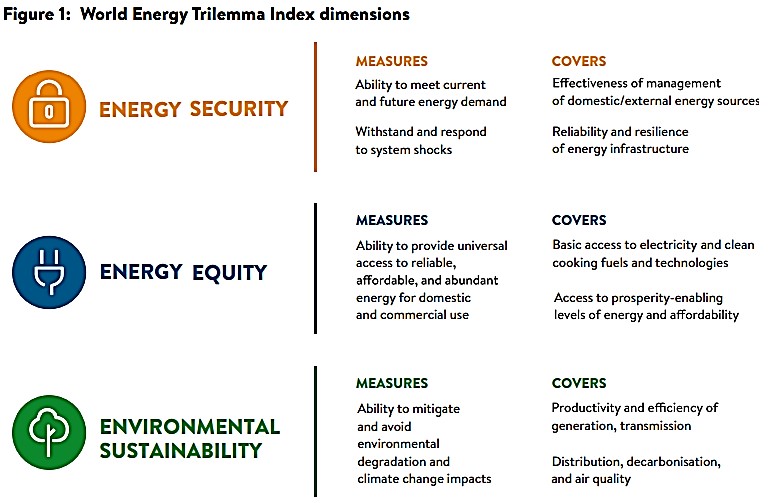
India and the Energy Trilemma
- Overall Rank: India has ranked 75th globally, showing a significant improvement with a stronger score rank in security. . India has a balanced trilemma score of BDD
- Energy Sustainability: Although Sustainability shows a grade D there is over 250% increase in Renewable Energy installations in last 6-7 years with remarkable improvement in CO2 emissions and air quality scores.
- Energy Security: India’s dependence on fuel imports has remained a challenge which has kept Security index down.
- Energy Equity: It has gone up considerably since mid 2000 with access to clean cooking and energy prices being the major contributor.
What has contributed to India’s Performance?
- Sustainable Development: India is on its transitional journey towards sustainable development and is one of the few countries that is on track to meet Paris Summit commitments. It has achieved an emission reduction of 24% by 2016 (from 2005 levels) and has more than 38% of its installed capacity as non-fossil capacity. India is playing a leading role in global collaboration on solar energy through the International Solar Alliance.
- Renewable Energy: India is in middle of one of the largest renewable energy expansion programs in the world. The installed renewable capacity increased from 16.8 GW at the end of 2009-10 to 97 GW in June 2021. India has set an ambitious target to achieve 175 GW renewable energy capacity by 2022 and aspires to achieve 500 GW by 2030.
- Self- Reliance: To reduce emissions from automobile sector India launched ‘National Electric Mobility Mission Plan’ under which subsidy is provided towards purchase of electric vehicles. India has ambitious plans to rapidly expand manufacturing of Solar PV, Batteries in India under its ‘Atmanirbhar Bharat’ Mission.
- Energy Security: India is introducing energy pricing reforms in coal, oil & gas, and Power sector (Real-Time Market, Smart Metering Program, Market Based Economic Dispatch, Green Energy Market - GTAM) to further open energy market.
- To improve energy storage, India is building a strategic storage capacity. With a plan to install 4000 MWh of Batteries, India is going ahead with the installation of large-size batteries for stabilizing the grid and Peak Load Management.
- To reduce dependence on imported fuel India has announced launch of National Hydrogen Mission in FY’22.
- Energy Access: Electricity access provision has been made to almost 100 % Households and aims to realize '24x7 Power for all. Since 2016 expansion of LPG connections as a clean and affordable fuel for cooking has been done with LPG penetration reaching almost 100%.
What are the Limitations of the Index?
- The Index cannot capture real-time Energy Trilemma performance due to the challenges of capturing large volumes of reliable data for a wide range of countries.
- As the Index shows aggregate policy effects, it does not identify the effectiveness of a particular policy; each policy interacts with a set of policy-specific and contextual factors unique to that country over different periods
- The Index uses 76 data sets. In a few instances, data for specific countries is not available (i.e. the data set has missing data), in which case missing data is replaced by the country group mean.
Conclusion: The world needs more sustainable energy and our relationship with energy and, consequently, with each other, is shifting and transforming. The need to involve more people and diverse communities in being better able to appreciate and navigate the role of energy in everyday life has never been greater.
Question: Discuss India’s performance on the World Energy Trilemma Index, 2021.
Source:
Red Crabs
This is image of red crabs that have migrated to the ocean at Australia's Christmas Island. Numerous red crabs took to the roads and bridges on Christmas Island in Australia, as part of their annual migration to the ocean. Red crabs all over the island leave their homes at the same time and start marching towards the ocean to mate and spawn. Male crabs lead the migration and are joined by females along the way. The island in north-western Australia witnesses the migration every year of all of its crab population. It is estimated to be around 50 million, making it the highest in the world.
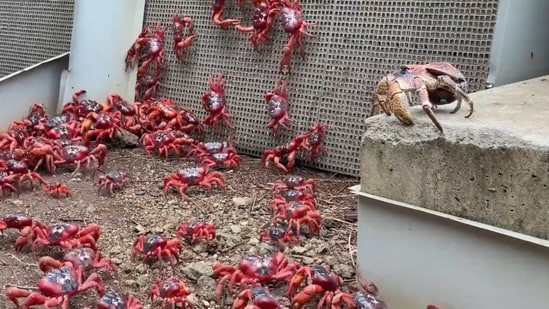
Source:
Index Funds
- Context: Passive investing through investing in index funds is becoming very popular among investors these days.
- An index fund is a type of mutual fund or exchange-traded fund (ETF) with a portfolio constructed to match or track the components of a financial market index, such as the SENSEX.
- As the name suggests, index funds invest in an index. They invest in stocks that constitute the index in the same proportion.
- They invest in stocks that constitute the index in the same proportion. The whole idea is to mimic the index.
- These funds provide a broad market exposure, low operating expenses/fees than actively managed funds and low portfolio turnover. They follow their benchmark index regardless of the state of the markets.
- Investing in index funds is extremely popular in most developed countrie Investors invest in these low cost index funds to take care of their long-term goals like retirement.
- Proponents of index investing say such outperformance will become rare once the market is fully developed.
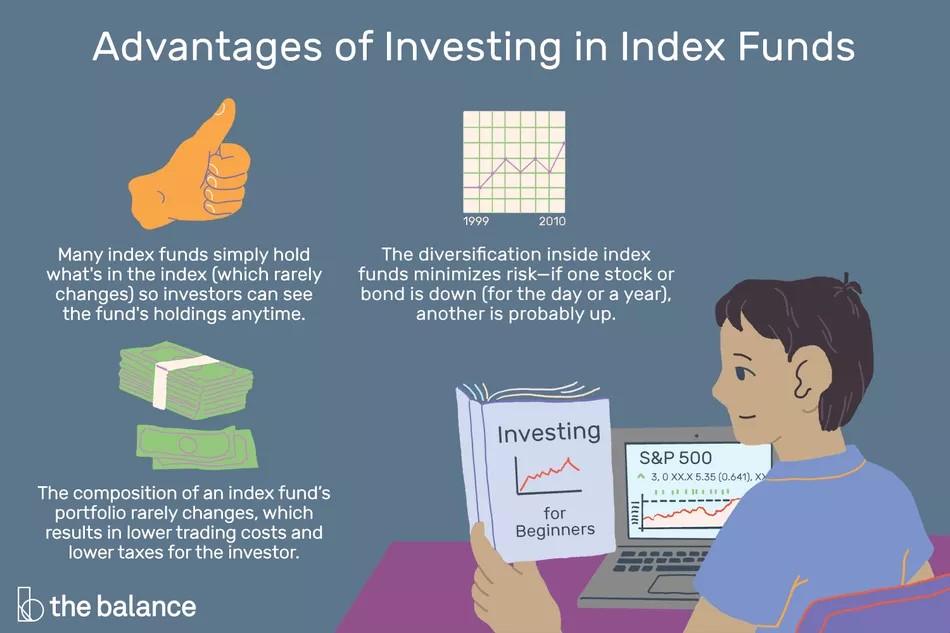
Source:
Image Source:
First fisheries business incubator
- Context: Union Minister of Fisheries, Animal Husbandry and Dairying has inaugurated a dedicated business incubator-LINAC- NCDC Fisheries Business Incubation Centre (LlFlC) in Gurugram
- It is India’s first-of-its kind incubator that would nurture fisheries start-ups under real market-led conditions.
- The incubation unit will provide various avenues such as training, converting entrepreneurial ideas into business models and distribute seed money to the new as well as existing business entrepreneurs.
- The National Cooperative Development Corporation (NCDC) is the implementing agency for the LIFIC.
- It has identified the first batch of 10 incubatees from four states-Bihar, Himachal Pradesh, Gujarat and Maharashtra and 6 among them are from newly-created Fish Farmers Producer Organizations with the support of the financial grant under the Pradhan Mantri Matsya Sampada Yojana (PMMSY)
- This will help India achieve its goal of 22 million tonnes of fish production and an export of Rs 1 lakh crore by 2025.
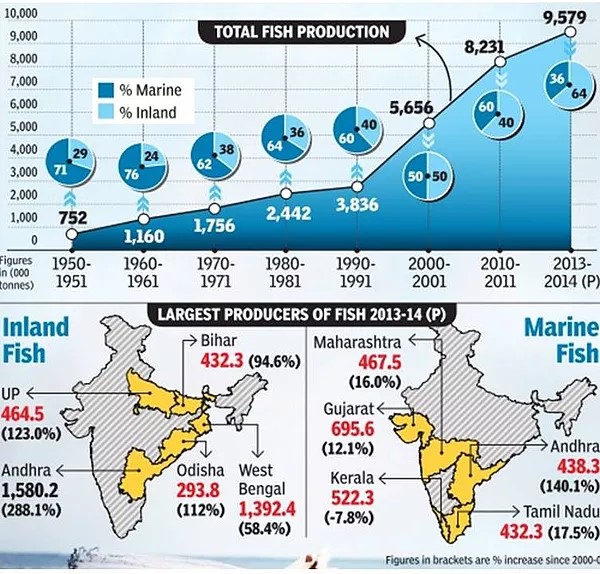
Source:
- Country’s first fisheries business incubator launched in Haryana’s Gurugram costing Rs. 3.23 crore
- First time in India: Rupala launches NCDC’s fisheries business incubator
Image Source:
Collision Avoidance Manoeuvre (CAM)
- Context: ISRO’s Chandrayaan-2 Lunar Orbiter recently performed a Collision Avoidance Manoeuvre (CAM).
- The Chandrayaan-2 Lunar Orbiter recently performed a CAM to mitigate the risk of passing very close to NASA’s Lunar Reconnaissance Orbiter (LRO).
- As both lunar orbiters are studying the moon from a Polar orbit (flying in a manner that nearly covers both the north and south poles), they come fairly close to each other near the Lunar poles
- CAMs are performed to mitigate the collision risk of satellites in orbit with other spacecraft or with space debris.
- However, such manoeuvres are also considered quite resource-hungry, as the satellite will have to expend its onboard liquid fuel (stored in a limited quantity) to perform the engine firing (manoeuvre).
- Since satellites are in space for a specified mission time, such unplanned firings of their engines can reduce their mission life, owing to the loss of its onboard fuel.
Source:
- Chandrayaan performs evasive manoeuvre to avoid collision with NASA’s orbiter
- Explained: How India’s Lunar Orbiter Chandrayaan-2 avoided Collision with NASA’s LRO
Image Source:
Autism Spectrum Disorder
- Context: A group of Indian researchers have developed a compound called “6BIO” to treat Autism Spectrum Disorder (ASD).
- ASD is a developmental disorder that affects communication and behaviour.
- Although autism can be diagnosed at any age, it is said to be a “developmental disorder” because symptoms generally appear in the first two years of life.
- It is known as a “spectrum” disorder because there is wide variation in the type and severity of symptoms that people experience.
- ASD occurs in all ethnic, racial, and economic groups.
- ASD does not have an appropriate pharmacological or genetic method of treatment.
- 6BIO is found to restore the neural functions not only when administered during development (equivalent of baby (1-2 years) and childhood stages (3-6 years)) but also after mid-childhood (7-11 years) when most of the brain regions are considered to have formed properly.
- It is found to help children with ASD learn and recall, be social, and alleviate other symptoms such as seizures or sleep issues.

Source:
- Indian researchers develop better therapeutics to treat Autism Spectrum Disorder
- Autism Spectrum Disorder
Image Source:
The monetary, fiscal challenges of cryptocurrency: IE
Essence: The article asks to shift the focus from micro to macro level problem that may arise when digital currency will gain traction. The article discusses the problems that are likely to arise is efficacy of monetary and fiscal policy, along with private digital currency competing with fiat currencies. The larger the monetary base of private currency there is more likelihood that it will make domestic monetary policy less potent in responding to business cycle needs and external shocks.
So, the countries should brace themselves to tackle the macro challenge which will emerge and compound if and when unbacked private digital currencies are seen as viable mediums of exchange.
Why you should read this article?
- To understand the challenges associated with privately issued cryptocurrencies.
- How these private currencies can pose threat to the monetary policy of the country
- The example of Latin America given in the article can be used in mains answer writing to support answer for monetary policy getting impacted with private digital currencies.
Source:
Promise of ‘one district, one product’: BL
Essence: The Article talks about the One District One Product (ODOP) programme in India. The objective of ODOP is to accelerate economic growth, generate employment, promote rural entrepreneurship and ultimately to realize the goal of Atmanirbhar Bharat. It is not only significant for economic realm but also socio-economic realm. The major idea behind the scheme is to transform district into exports hubs and linking local production houses to global supply chain. This will benefit in changing the lives of rural population. Before India, implementation of such a scheme has happened in countries like Japan, Thailand and Philippines. In Indian context, the policy should include the ownership of the initiative, identification of stakeholders and streamlining initiatives such as registration of GI. ODOP offers a transformative opportunity to integrate, strengthen and streamline regional products. Various initiatives may be replicated under ODOP as well as to realize ‘vocal for local’ objective. It is important to bring them under one umbrella.
Why to read this article?
- To know the aims and objectives of ODOP, what is its current status in India and what have been similar experiences around the world
- To understand what all to keep in mind in terms of policy initiatives.
Source:
The government should prepare for a sustained spell of inflation: LiveMint
Essence: The editorial highlights the issue of rising inflation in India while there is a decline in employment and its benefits. Though the CPI inflation is decreasing to 4.5%, the WPI inflation level has been in double digits for a sustained period. While some food items’ prices have declined (fruits, vegetables, meat, dairy products, etc.), some items like wheat, edible oils have seen price rise. This is partly due to rise in petroleum prices internationally as certain food crops get diverted towards production of ethanol. Other factors contributing could be hoarding of food grains due to pandemic supply chain constraints. Rise in input costs like fertilizers prices and electricity cost have also resulted in higher prices.
The government needs to control these rising prices along with ensuring that the food producers don’t get deprived of the basic minimum profit during food production. To achieve this, the government could initiate expanding PDS, addition of nutritive content like pulses and oilseeds in food distribution basket and inclusion through schools and anganwadi centers.
Why you should read this article?
- To understand the reasons for rising CPI inflation esp relating to food articles in India.
- To know how to control the impacts of food inflation.
Source:
Janjatiya Gaurav Divas: An initiative for betterment
Background
- The Government has designated November 15 as the Janjatiya Gaurav Divas which is the birthday of Bhagwan Birsa Munda.
- Despite the fact that tribals have a place in Indian culture and history, the British government labelled the 'descendants' of Guha as criminals when it passed the Criminal Tribes Act in 1871.
Why ‘Janjatiya Gaurav Divas has been initiated?
- The reason is to ensure that the freedom fighters from diverse tribal communities who fought for India's independence receive their due respect.
- Tribals have been on the receiving end of the atrocities in early times be it the monarchy or the Britisher or mainstream population.
- Though efforts have been made to bring them at par with the rest of the country, proper implementations have always being questioned.
- Ensuring proper development of HDI of the tribal group is also important to bring the all round development of the tribes.
Quote:
Tribes don't need Congressmembers' sympathy. What tribes need is for us to properly exercise our duty.- Sharice Davids
Source:
Share the article
Get Latest Updates on Offers, Event dates, and free Mentorship sessions.

Get in touch with our Expert Academic Counsellors 👋
FAQs
UPSC Daily Current Affairs focuses on learning current events on a daily basis. An aspirant needs to study regular and updated information about current events, news, and relevant topics that are important for UPSC aspirants. It covers national and international affairs, government policies, socio-economic issues, science and technology advancements, and more.
UPSC Daily Current Affairs provides aspirants with a concise and comprehensive overview of the latest happenings and developments across various fields. It helps aspirants stay updated with current affairs and provides them with valuable insights and analysis, which are essential for answering questions in the UPSC examinations. It enhances their knowledge, analytical skills, and ability to connect current affairs with the UPSC syllabus.
UPSC Daily Current Affairs covers a wide range of topics, including politics, economics, science and technology, environment, social issues, governance, international relations, and more. It offers news summaries, in-depth analyses, editorials, opinion pieces, and relevant study materials. It also provides practice questions and quizzes to help aspirants test their understanding of current affairs.
Edukemy's UPSC Daily Current Affairs can be accessed through:
- UPSC Daily Current Affairs can be accessed through Current Affairs tab at the top of the Main Page of Edukemy.
- Edukemy Mobile app: The Daily Current Affairs can also be access through Edukemy Mobile App.
- Social media: Follow Edukemy’s official social media accounts or pages that provide UPSC Daily Current Affairs updates, including Facebook, Twitter, or Telegram channels.


